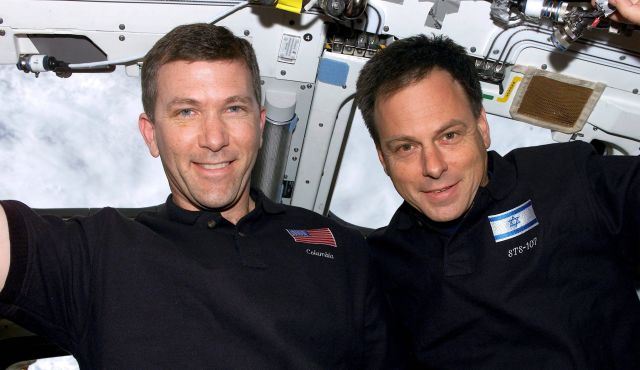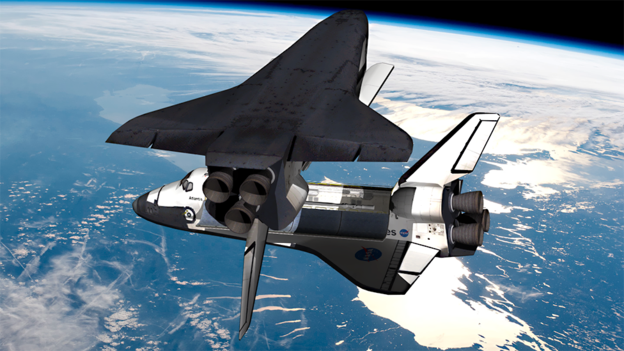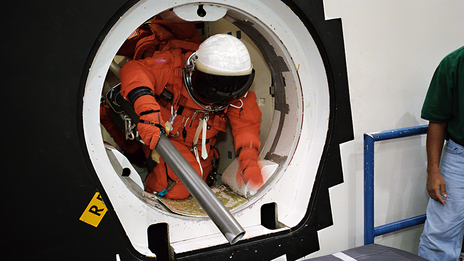.


.
Columbia shuttle crew could have been saved, says NASA engineer
David Baker, who worked on the space shuttle program, told the BBC the Atlantis was available for a daring mission fraught with its own danger.
.

Space Shuttle Columbia Commander Rick Husband, left, and Israeli payload specialist Ilan Ramon in the Columbia, January 21, 2003, in a photo supplied by NASA..
.
The fated crew of the Space Shuttle Columbia could have been saved in theory, according to a NASA engineer, who spoke to the BBC.
Israeli astronaut Ilan Ramon and six other crew members perished when their space shuttle attempted reentry into Earth's atmosphere on February 1, 2003. However, its fate was sealed just seconds into the launch when a lump of foam came loose during takeoff and punctured the leading edge of one of Columbia's wings.
David Baker, who worked on the shuttle program, told the BBC that during research for an upcoming lecture at the British Interplanetary Society, "he studied plans that suggest that a dramatic and audacious orbital rescue mission could have been launched – if only Mission Control had known about the danger in time."
According to Baker, the Atlantis space shuttle was close to being ready for a March 1 launch when Columbia lifted off on January 16. Columbia only had enough supplies to keep the astronauts alive for 30 days, so a rescue mission would have required recognizing the problem by Day 2 and speeding up the preparation schedule for Atlantis from six weeks to four weeks.
If that could have been accomplished, then Atlantis could have been sent into an orbit bringing it within six degrees to Columbia at a 90 degree angle – requiring skilled piloting to prevent the tails from colliding. With a reduced crew of four astronauts, while two of them would pilot the Atlantis, the other two would begin the rescue, first bringing over lithium hydroxide canisters to reduce life-threatening carbon dioxide levels on the Columbia. Then the Atlantis astronauts would position an extendable pole between the two shuttles to guide the crew of the Columbia to safety.
Two by two, the Columbia crew would spacewalk to the Atlantis, in a process that would take at least 48 hours because of the time it takes to don a space suit and avoid a fateful mistake when moving from airlock to airlock, explained Baker.
So why did NASA never attempt such a rescue mission?
“The big mistake was not having a sufficiently detailed and intensive analysis soon enough,” Baker told the BBC. “It just didn’t appear the damage was going to be that bad until, as evidence built day by day, it became very clear.”
Another issue was that NASA did not display the "failure is not an option" attitude that saved the lives of the Apollo 13 astronauts when their spacecraft was damaged on the way to the moon in 1970, added Baker.
“It would have been possible but frankly the mindset at NASA was so rigid compared to the lightening decisions and quick responses we had during Apollo,” he said.
Quelle: HAARETZ
.
Nasa’s out-of-this-world plan to rescue a Space Shuttle

A retired Nasa engineer reveals details of a daring plan that could have been used to rescue a shuttle crew facing certain death stranded in orbit.
.
The fate of the seven members of STS-107’s crew was sealed within 90 seconds of launch. As Space Shuttle Columbia rose through the perfect clear sky above Florida on 16 January 2003, a lump of foam came loose from the strut holding the craft’s nose to its giant orange fuel tank. With the spacecraft climbing at more than twice the speed of sound, the foam lump slammed into the fragile leading edge of the wing with the force of a concrete block.
Seventeen days later the spacecraft re-entered the atmosphere and broke apart. The disaster killed everyone on board, and ultimately sounded the death knell for the Space Shuttle programme.
But could the astronauts have been saved? A Nasa engineer who worked on the shuttle programme from the very start, David Baker, has written official reports and books on the spaceplane. During research for a forthcoming lecture at the British Interplanetary Society, he studied plans that suggest that a dramatic and audacious orbital rescue mission could have been launched – if only Mission Control had known about the danger in time.
When Columbia lifted from its launchpad, footage captured by high-speed cameras showed foam coming loose and striking the orbiter. Several days later images taken by ground telescopes indicated the wing might have been damaged. “The big mistake was not having a sufficiently detailed and intensive analysis soon enough,” says Baker. “It just didn’t appear the damage was going to be that bad until, as evidence built day by day, it became very clear.”

Several plans had been developed over the years to save a crew stranded in orbit. For most missions, the shuttle could have simply docked with the International Space Station (ISS) and used it as a lifeboat. However, this particular shuttle mission was in a completely different orbit to the ISS – and neither had sufficient engine power to change their flightpath. Even more crucially, this mission did not carry spacesuits suitable for spacewalks, so going outside to fix any damage – even if that were possible – was out of the question.
Time was ticking. STS-107’s mission was supposed to last 17 days but the crew had enough lithium hydroxide canisters – used to scrub toxic levels of carbon dioxide from the air – for an absolute maximum of 30 days. After that the crew would die of asphyxiation.
The only possible rescue option? Send up another shuttle to bring the crew back to Earth.
What sounds impossible was actually feasible – at least in theory. As it happened, Columbia’s sibling, Atlantis, was being prepared at Cape Canaveral for a launch on 1 March. “Its engines were installed,” says Baker, “and it was in a pretty neat condition to get it over to the vehicle assembly building fast and launch it.”
But as time was of the essence, the craft would have had to be readied for launch at an unprecedented pace. To do that within four weeks, rather than six, would have been tough but doable. With round-the-clock shifts, this would have involved streamlining every launch process – from rewriting software and refining procedures to training the rescue crew. This was the very “failure is not an option” attitude that saved the astronauts of Apollo 13 when their spacecraft was damaged on the way to the Moon in 1970.
In the subsequent disaster inquiry, the Columbia Accident Investigation Board formalised a rescue plan for future missions. But Baker told me that a feasible plan could have been launched during the mission, if the go-ahead was given at day two, and the procedures were in place to make it possible. According to Baker, this is how the original unpublished concept would have played out.
On day two of the STS-107 mission, the Columbia astronauts are alerted to the danger. Systems are powered down, exercise is restricted to reduce the production of carbon dioxide and food is rationed. Meanwhile, with the world’s media looking on, Atlantis is rushed towards launch. With just hours to spare, and with carbon dioxide levels on Columbia rising to dangerous levels, the second shuttle blasts into orbit with four crew on board.
Once the spacecraft reaches the stricken craft, the Atlantis pilot positions his shuttle above and at right angles to Columbia to avoid the tails hitting each other. “You need to keep about 20ft feet (6m) away for two days,” says Baker. “Two crew members on board each shuttle would do that.” This would have involved exceptional piloting skills. With each spacecraft spinning around the Earth at seven kilometres per second, a small lapse in concentration could have resulted in catastrophe.
Meanwhile the other two Atlantis astronauts begin the first of many spacewalks, delivering lithium hydroxide canisters to the Columbia crew to bring down life-threatening carbon dioxide levels. They also deliver two spacesuits. Next, the Atlantis astronauts position an extendable pole between the two Shuttles. This will be used to guide the Columbia crew across the handful of metres between the two spaceplanes.
With everything in place, two at a time, Columbia astronauts are helped out of the airlock, across the gap and into the Atlantis airlock. “They would have then had to take their suits off and repeat the process again to husband out the next two,” Baker explains.
Despite what the movie Gravity might have you believe, it takes more than a couple of minutes to put on a space suit. And even a relatively simple spacewalk is fraught with difficulties. One slip could send an astronaut spinning off into the void. Transferring the whole seven-person crew would have taken at least 48 hours.
“The final act of the last man out of Columbia”, says Baker, “is to configure the switches so that mission control can access the guidance system to fire the retro rockets to bring Columbia down to its doom.” The plan even called for two astronauts to investigate the damaged wing.
Assuming everything has gone more or less as intended, 11 astronauts are now on board Atlantis. “This would be more than have ever flown before,” says Baker, “some would be strapped on couches on the floor – this really would have been an emergency return.” Nevertheless, they had a good chance of making it all back alive.
“What if?” scenarios are always beguiling, but this one was not only possible but also planned for. “It could have been done,” says Baker. “It would have been possible but frankly the mindset at Nasa was so rigid compared to the lightening decisions and quick responses we had during Apollo.”
After launch, the Columbia crew were seemingly oblivious to any danger. As the hours ticked away, so had their only real chance of rescue.
.

Moving the whole seven-person crew on board Columbia to Atlantis would have taken at least 48 hours (Nasa)
Quelle: BBC
4417 Views

